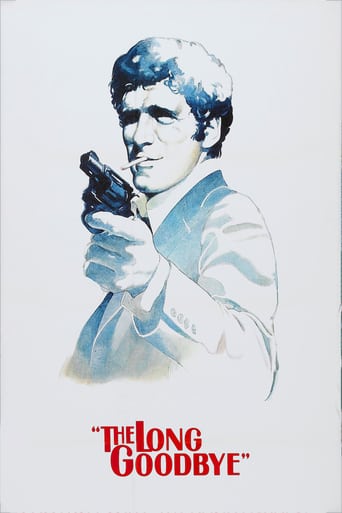

Beautiful, moving film.
... View MoreInstead, you get a movie that's enjoyable enough, but leaves you feeling like it could have been much, much more.
... View MoreThis movie was so-so. It had it's moments, but wasn't the greatest.
... View MoreThe movie's neither hopeful in contrived ways, nor hopeless in different contrived ways. Somehow it manages to be wonderful
... View MoreKubrick famously asked Altman how he knew the shot of McCabe lighting his cigar in the snow was the right one; this 1973 film has many moments like those: not just the beautiful flash of the match being struck, but movements to which the camera has a perfect affinity: yoga contortions, squinting eyeballs, violent projections, cat walks. It'd be 5 stars silent, something more with those signature sound experiments.
... View MoreI like the hard-to-solve mystery we get here. Actually, they don't even come close to giving us enough clues to solve it, hence the difficulty. But in that we feel we're up against it like the protagonist, detective Phil Marlowe, played by Elliot Gould.Times have really changed for Marlowe since 1946, when he was played by Humphrey Bogart. Then he was cool, implacable, wore a fedora a lot, and wound up with babe Lauren Bacall. That was the only strain of the plot viewers could follow. There were some dead bodies, smoking guns, and tough questions from cops along the way. In this movie it's 1973, and Marlowe still think he's cool but that opinion is not so widespread this time - he's being played for a sucker by at least half the cast, including a longtime friend, and his own cat. He unravels the mystery mostly out of a lack of having anything better to do, which he clearly stood in need of.Director Robert Altman follows his own ideas about how to communicate visually. Like when he changes scene to a hospital, he doesn't do any kind of establishing long shot, he shows a closeup of a light over a patient's bed. His montages create a kind of equivalent of our human experience, where we use our minds to focus on detail. He usually winds up with scenes that feel like we're watching something actually happen. But he does know how to use visuals for dramatic power when he wants, as the ending makes clear. Some of the performances he gets from actors are amazing, like Mark Rydell as psychotically dangerous gangster Marty Augustine. The way he works himself into a rage with his rants changes gears from funny to frightening at high speed, and I can't believe it didn't influence Joe Pesci's performance in "Goodfellas."Not everything works here, like Gould smearing fingerprint ink on his face then breaking into Al Jolson at police headquarters, but on the whole a fairly engrossing take on detective mysteries.
... View MoreHello to a missing movie of my youth, i remember well the film coming out and my interest in it, but after a 43 year wait thanks to DVD i have ticked off Altman's "The Long Goodbye". As a piece of drama, as a piece of detective fiction, as a piece of the private eye genre and Chandler, it is as i suspected a complete failure. The setting is all wrong, the then modern day LA. The running gag of the topless hippie teenage neighbours, that Marlowe has so little interest in, perhaps because he has been sacked by his demanding cat, is abstract in the extreme, but it is one of a number of off beat jokes that work, at least from the vista of viewing the movie from the distance of 4 and a half decades. Simply as "film Noir" or a detective genre film, let alone as entertainment, little works. Gould is miscast, the plot fragmentary, not always Altman's fault i admit, but as a piece of eccentric 70's cinema, perhaps as modern art, the film is not without several interesting points. Time has made the 1973 setting all but inspired due to the fashions, clothes, make up, attitudes, the big cars or the over written syn ism,so typical of the late Vietnam era. For me the 1967-1974, pr block buster "Jaws"/"Star Wars" era was golden age of mature grown up American cinema, of which Altman's "The Long Goodbye" is a welcome addition, perhaps on a second viewing i will enjoy it more, so for now a interesting plus movie that i give a 7/10 score.
... View MoreRaymond Chandler's Detective Philip Marlowe fell Asleep and is Awakened 20 Years Later in the now Smogged Hazed Los Angeles and seems OK with it although He is undoubtedly Dazed and Confused.That's the Premise and You are Asked to Give In to that Premise in No Uncertain Terms and Go with the Flow. Marlowe Sure Does. He Stumbles and Mumbles barely trying to regain His sense of Place and Time. He still Smokes continuously and retains a Cynical Humor about the People that still Populate the "City of Angels".A Conglomerate of Artistic Displays are on hand in Altmanesque Fashion. The peppering Overlapping Dialog, a Fluid and Attentive Constantly Moving Camera, and a remarkable Ensemble Supporting Cast. Henry Gibson, Sterling Hayden, Director Mark Rydell, Nina Van Pallandt, and Baseball Pitcher Jim Bouton all Stamp the Film with Indelible Quirky Characters.The Film is an Homage to Hollywood and Chandler. Altman takes a Bite out of Tinseltown but is Kinder to Marlowe, Chandler, and Film-Noir. The Director is at His most Playful here and most of it Works although Loud and Angry Outbursts from Purists and Traditionalists say otherwise.It's Odd, Offbeat, and Obscure, Against the Grain of the Seventies Neo-Noir Realism and was Dismissed and Booed upon its Initial Release.Others saw a Singular Filmmaking Artist at Work and the Movie has Gained Elevated Status over the Years and has become sort of a Cult Movie or Novel Curiosity. Elliott Gould as Marlowe and Altman have Weathered the Controversy, and the Film Emerges as a Seventies Highlight.
... View More